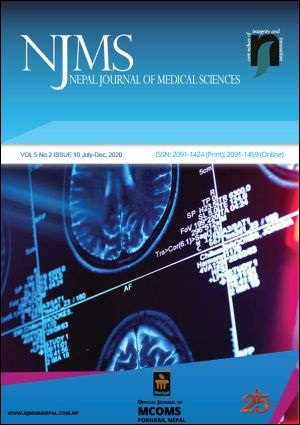Spectrum of Injuries Inflicted and their Consequences Following Wild Animals Attack: Retrospective Study
DOI:
https://doi.org/10.3126/njms.v5i2.36706Keywords:
Human Wildlife Conflict, Multidisciplinary Approach, Protective AreaAbstract
Introduction: Human-wildlife conflict in the Himalayan kingdom of Nepal is the major concern in and around the protected area due to dramatic change in the ecosystem which includes a rise in human population and their basic requirements that leads to loss of natural habitat for agriculture farming and residential purpose. On the other hand, successful conservation programme in some protective areas leads to a rise in a number of wildlife. This conflict ultimately leads to damage of the crops, property, livestock and the most important human casualties which is the main focus of this study.
Methods: This is a hospital-based retrospective study in which 32 patients visiting the emergency and outpatient department with a history of wild animals attack were included. Advanced trauma life support protocol for polytrauma patients was followed. Anti tetanus and anti-rabies prophylaxis given followed by antibiotics coverage. Operative and multidisciplinary interventions were made as per the requirement.
Results: Out of the total 32 patients, soft tissue injury Oestern-Tscherne grade 3 was the commonest type of injury seen in 19(59.4%) of the cases, the commonest species involved was rhinoceros 8(25%). The anatomical site most commonly involved was lower limb 10(31.3%). Fracture fixation was required in 8(25%) cases. The commonest complication was wound infection in 5(16%) cases.
Conclusion: This research elaborates the current scenario of human-wildlife conflict, facilitates to identify and face the common type of injuries, their complications, the role of a multidisciplinary approach and hence implement certain treatment protocols as a part of effective management to avoid major consequences to public health.
Downloads
Downloads
Published
How to Cite
Issue
Section
License
Copyright © by Nepal Journal of Medical Sciences. The ideas and opinions expressed by authors of articles summarized, quoted, or published in full text in this Journal represents only opinions of authors and do not necessarily reflect the official policy of Nepal Journal of Medical Sciences or the institute with which the author(s) is (are) affiliated, unless so specified.




